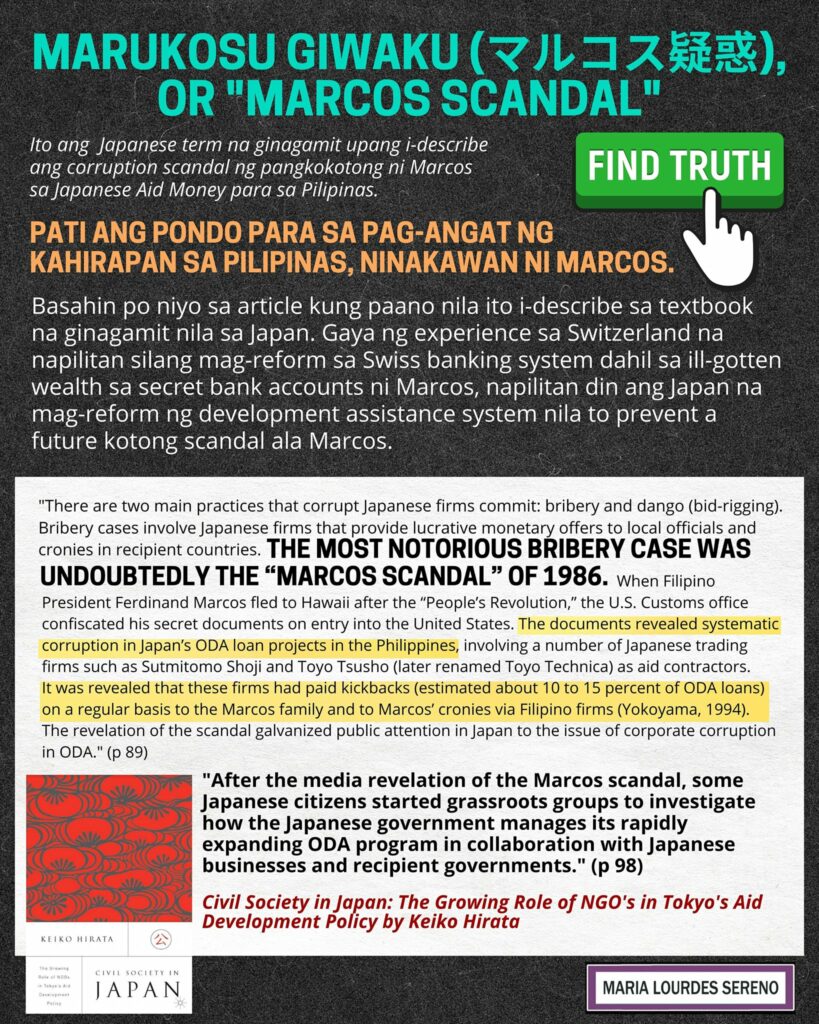GANITO PO ITURO SA TEXTBOOK SA JAPAN ANG MARCOS SCANDAL NG CORRUPTION
By Maria Lourdes Sereno

Excerpts po ito sa mga libro, at may links po sa screenshots ng pages mismo sa libro. Sabi ng page follower natin ay ito daw ang dini-discuss nila sa kaniyang klase sa Japan. Kayo na po ang humusga kung tama yung sinabi niyang, bilang Pilipino, nanliit siya nang pinag-uusapan ang mga leksyong ito. Sabi pa niya, bakit kinailangang sa Japan niya pa ito malaman — kasi hindi ito itinuturo sa Pilipinas. KAYA PO BA NATING PARANGALAN ANG PANGULO NA PINAG-UUSAPAN SA GANITONG KAHIYA-HIYANG PARAAN SA IBANG BANSA GAYA NG JAPAN?
![]() “There are two main practices that corrupt Japanese firms commit: bribery and dango (bid-rigging). Bribery cases involve Japanese firms that provide lucrative monetary offers to local officials and cronies in recipient countries. The most notorious bribery case was undoubtedly the “Marcos Scandal” of 1986. When Filipino President Ferdinand Marcos fled to Hawaii after the “People’s Revolution,” the U.S. Customs office confiscated his secret documents on entry into the United States.These documents were later made available to the U.S. House Foreign Affairs Subcommittee on East Asia and Pacific and to the public.The documents revealed systematic corruption in Japan’s ODA loan projects in the Philippines, involving a number of Japanese trading firms such as Sutmitomo Shoji and Toyo Tsusho (later renamed Toyo Technica) as aid contractors. It was revealed that these firms had paid kickbacks (estimated about 10 to 15 percent of ODA loans) on a regular basis to the Marcos family and to Marcos’s cronies via Filipino firms (Yokoyama, 1994).The revelation of the scandal galvanized public attention in Japan to the issue of corporate corruption in ODA.” —Civil Society in Japan: The Growing Role of NGO’s in Tokyo’s Aid Development Policy by Keiko Hirata, page 89
“There are two main practices that corrupt Japanese firms commit: bribery and dango (bid-rigging). Bribery cases involve Japanese firms that provide lucrative monetary offers to local officials and cronies in recipient countries. The most notorious bribery case was undoubtedly the “Marcos Scandal” of 1986. When Filipino President Ferdinand Marcos fled to Hawaii after the “People’s Revolution,” the U.S. Customs office confiscated his secret documents on entry into the United States.These documents were later made available to the U.S. House Foreign Affairs Subcommittee on East Asia and Pacific and to the public.The documents revealed systematic corruption in Japan’s ODA loan projects in the Philippines, involving a number of Japanese trading firms such as Sutmitomo Shoji and Toyo Tsusho (later renamed Toyo Technica) as aid contractors. It was revealed that these firms had paid kickbacks (estimated about 10 to 15 percent of ODA loans) on a regular basis to the Marcos family and to Marcos’s cronies via Filipino firms (Yokoyama, 1994).The revelation of the scandal galvanized public attention in Japan to the issue of corporate corruption in ODA.” —Civil Society in Japan: The Growing Role of NGO’s in Tokyo’s Aid Development Policy by Keiko Hirata, page 89
![]() “After the media revelation of the Marcos scandal, some Japanese citizens started grassroots groups to investigate how the Japanese government manages its rapidly expanding ODA program in collaboration with Japanese businesses and recipient governments.” —Civil Society in Japan: The Growing Role of NGO’s in Tokyo’s Aid Development Policy by Keiko Hirata, page 98
“After the media revelation of the Marcos scandal, some Japanese citizens started grassroots groups to investigate how the Japanese government manages its rapidly expanding ODA program in collaboration with Japanese businesses and recipient governments.” —Civil Society in Japan: The Growing Role of NGO’s in Tokyo’s Aid Development Policy by Keiko Hirata, page 98
————
![]() “Ferdinand and Imelda Marcos dominated the country for two decades in the 1970s and 1980s under the so-called “conjugal dictatorship”, in the process greatly enriching themselves (by some estimates depositing as much as $10 billion in foreign banks). The Marcos administration in the 1970s and early 1980s saw one scandal after another, including one that involved skimming 10–15% of Japanese Overseas Economic Cooperation Fund loans. Operation Big Bird, the attempt to recover the billions that the Marcoses stashed away in Swiss banks, failed to retrieve a dime.” —Global Corruption from a Geographic Perspective by Barney Warf, page 178
“Ferdinand and Imelda Marcos dominated the country for two decades in the 1970s and 1980s under the so-called “conjugal dictatorship”, in the process greatly enriching themselves (by some estimates depositing as much as $10 billion in foreign banks). The Marcos administration in the 1970s and early 1980s saw one scandal after another, including one that involved skimming 10–15% of Japanese Overseas Economic Cooperation Fund loans. Operation Big Bird, the attempt to recover the billions that the Marcoses stashed away in Swiss banks, failed to retrieve a dime.” —Global Corruption from a Geographic Perspective by Barney Warf, page 178
Note: The Philippine eventually recovered the ill-gotten wealth of the Marcoses that were stashed in 5 Swiss accounts in 2003.
![]() Marcos Yen of Corruption
Marcos Yen of Corruption
https://drive.google.com/…/1hfmcCJ9t0mOQ4SOsDoQQmR…/view
![]() Excerpt from “The Growing Role of NGO’s in Tokyo’s Aid Development Policy” by Keiko Hirata
Excerpt from “The Growing Role of NGO’s in Tokyo’s Aid Development Policy” by Keiko Hirata
https://drive.google.com/…/1-Cq-kE-IXDrRUA7…/view…
![]() Excerpt from “Global Corruption from a Geographic Perspective” by Barney Warf
Excerpt from “Global Corruption from a Geographic Perspective” by Barney Warf
https://drive.google.com/…/1z90…/view…
